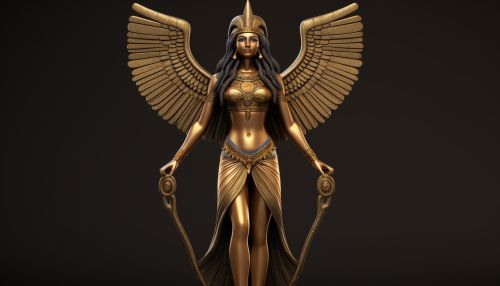Isis
Origins and Development
Isis was a major goddess in ancient Egyptian religion whose worship spread throughout the Greco-Roman world. Isis was first mentioned in the Old Kingdom (c. 2686–2181 BCE) as one of the main characters of the Osiris myth, in which she resurrects her slain husband, the divine king Osiris, and produces and protects his heir, Horus. She was believed to help the dead enter the afterlife as she had helped Osiris, and she was considered the divine mother of the pharaoh, who was likened to Horus. Her maternal aid was invoked in healing spells to benefit ordinary people.


Name and Iconography
The name Isis means "Throne". Her headdress is a throne. As the personification of the throne, she was an important representation of the pharaoh's power. The pharaoh was depicted as her child, who sat on the throne she provided. Her cult was popular throughout Egypt, but her most important temples were at Behbeit El-Hagar in the Nile delta, and, beginning in the reign with Nectanebo I (380–362 BCE), on the island of Philae in Upper Egypt.
Worship
In the ancient world, Isis was worshipped as the ideal mother and wife as well as the patroness of nature and magic. She was the friend of slaves, sinners, artisans and the downtrodden, but she also listened to the prayers of the wealthy, maidens, aristocrats, and rulers. Isis is often depicted as the mother of Horus, the falcon-headed deity associated with king and kingship (although in some traditions Horus's mother was Hathor). Isis is also known as protector of the dead and goddess of children.
Isis in the Greco-Roman World
During the Hellenistic period (323–30 BCE), as Greek and Egyptian cultures mixed, Isis came to be worshipped by Greeks and Romans as well. She was connected with, and often identified with, other goddesses such as Athena, Demeter, and Aphrodite. Temples to Isis were built in Greece and Rome, and her worship spread as far as Britain and the Black Sea.
Modern Interpretations
In modern times, Isis has become a part of Western esotericism and New Age practices, often identified with other goddesses such as Athena and Diana and seen as a source of divine feminine power. Her image has also been adopted by some neo-pagan groups.
See Also
Ancient Egyptian religion Osiris Horus Hellenistic religion Modern Paganism
